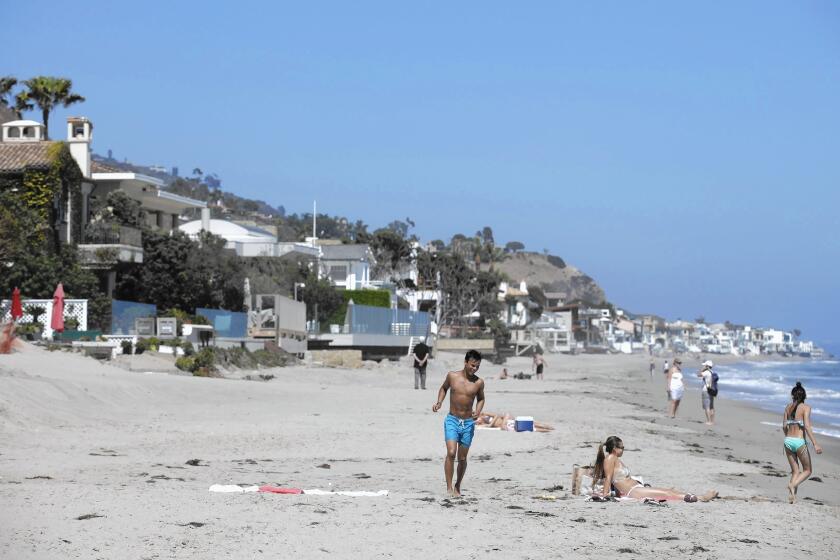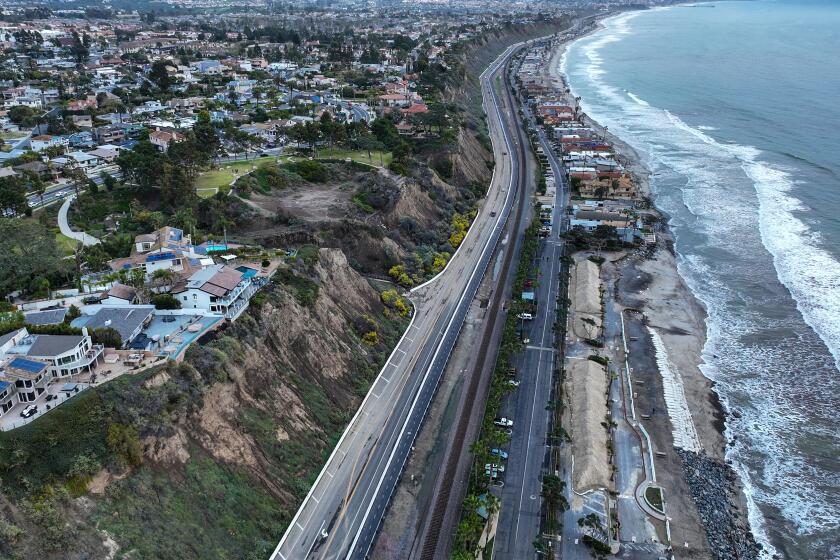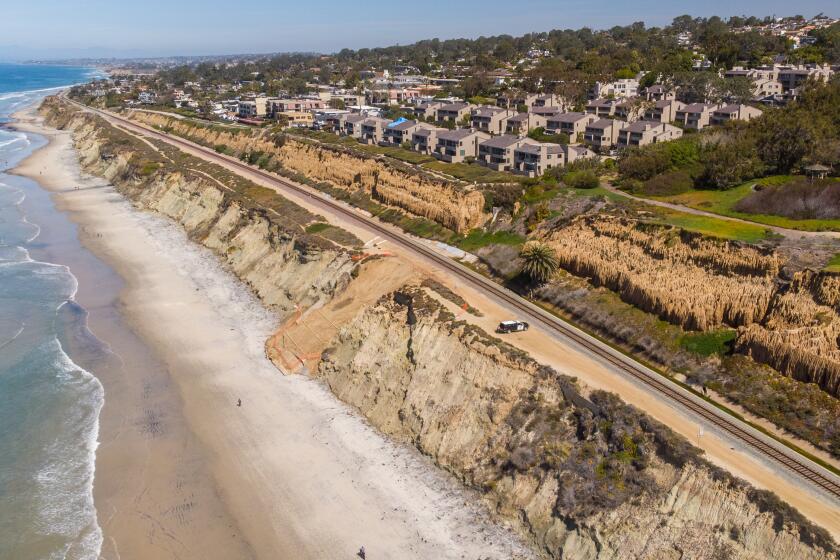‘Hidden’ no more: Coastal Commission OKs new public path to Malibu beach
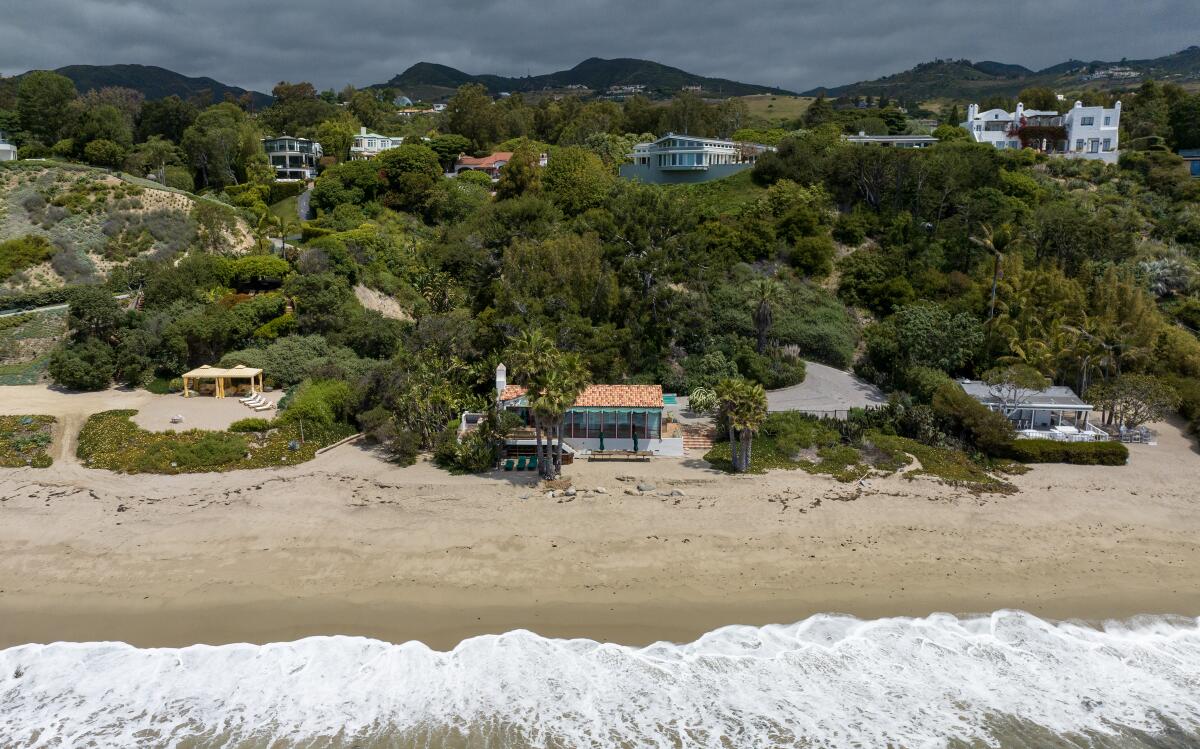
- Share via
The June gloom hung heavy along the empty shore of Escondido Beach last week, where not a soul was in sight save for a lone surfer skimming the distant waves.
The sandy stretch has long been a haven for intrepid Malibu beachgoers, sandwiched as it is between Geoffrey’s Restaurant to the east and Paradise Cove to the west, with no other entry points nearby.
But after a 40-year battle, the California Coastal Commission on Wednesday unanimously approved an agreement with two homeowners that will restore a long-obscured public access point to Escondido Beach from the Pacific Coast Highway.
It will mark the first new direct or ‘vertical’ path from the highway to a beach in Malibu since 2015. Wealthy residents here have been known to use considerable resources to deter such access to the shoreline.
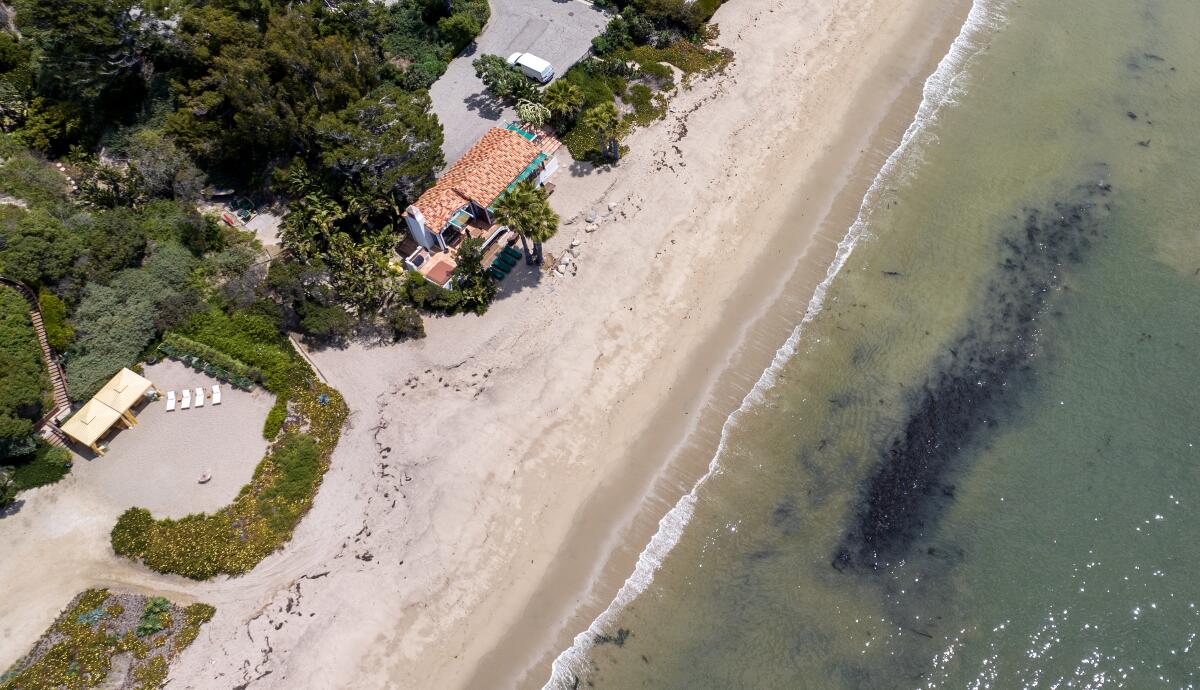
State officials hailed the vote as a major victory for the public, as well as the California Coastal Act, one of the nation’s strongest land use laws, and one that seeks to maximize and protect public access to the coast.
“It’s so hard for us to get new access to the coast, and new vertical accessways are like unicorns — they just don’t exist, especially in Malibu,” said Lisa Haage, chief of enforcement for the Coastal Commission. “Settling this case without litigation is huge. This is like flying to the moon or something.”
In the decades-long struggle to make the beaches fronting California’s well-heeled coastal communities more accessible to the public that owns them, a mile-long stretch of Malibu known as Billionaires’ Beach has been the site of a particularly pitched battle.
At the center of the matter are two adjacent properties along the 27900 block of Pacific Coast Highway, where enforcement officials say the homeowners and their predecessors violated the Coastal Act by obscuring public accessways, or easements, from the highway to the beach.
“Escondido Beach means ‘Hidden Beach’ in Spanish, and the lack of public access here kept it hidden from many people that could not find a nearby public trail to the beach, or even a public parking spot, over the decades,” commission staff wrote in a report ahead of Wednesday’s decision.
The properties are currently owned by Frank Mancuso, former chief executive of Paramount Pictures and MGM, and the family of Don Wildman, founder of Bally Total Fitness. Wildman died in 2018, leaving the property to his heirs.
But the violations stretch back to the early 1980s, when prior owners Ken and Jeannette Chiate and Marilyn and Roger Wolk wrongly recorded the location of the easement along a steep grade instead of a gently sloped arroyo, according to the report.
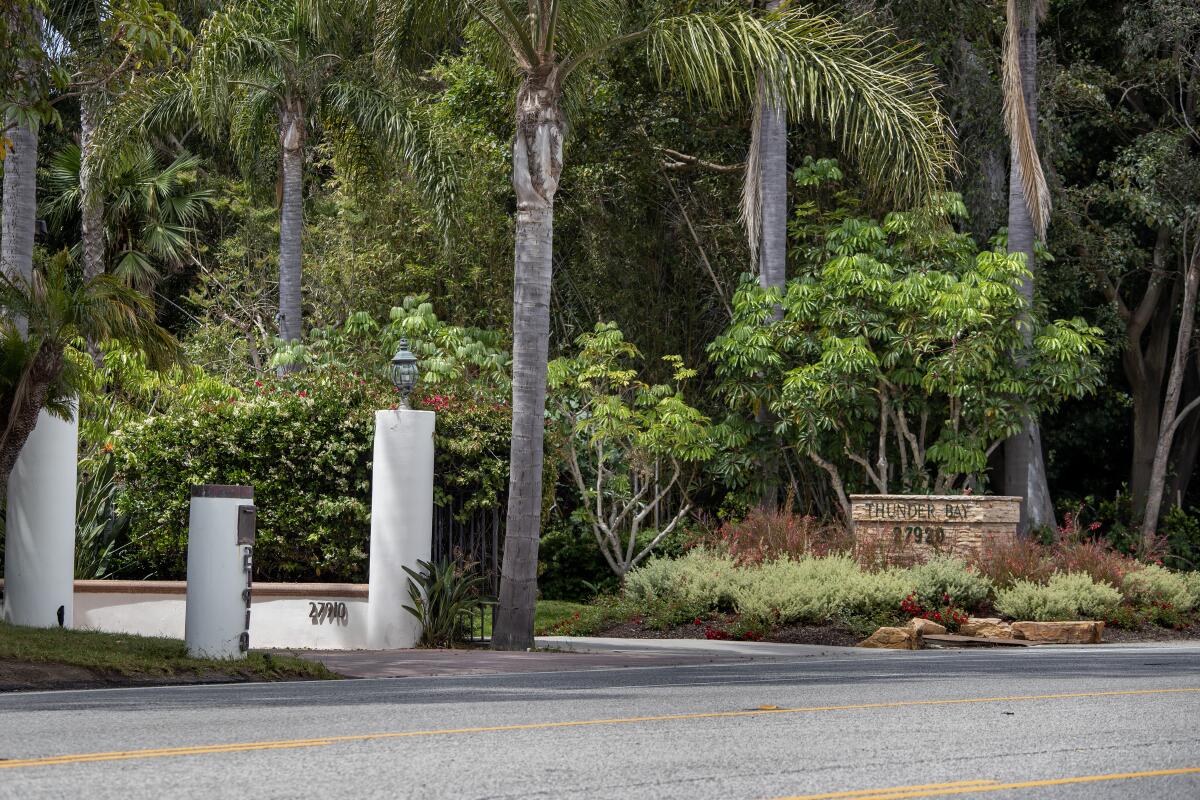
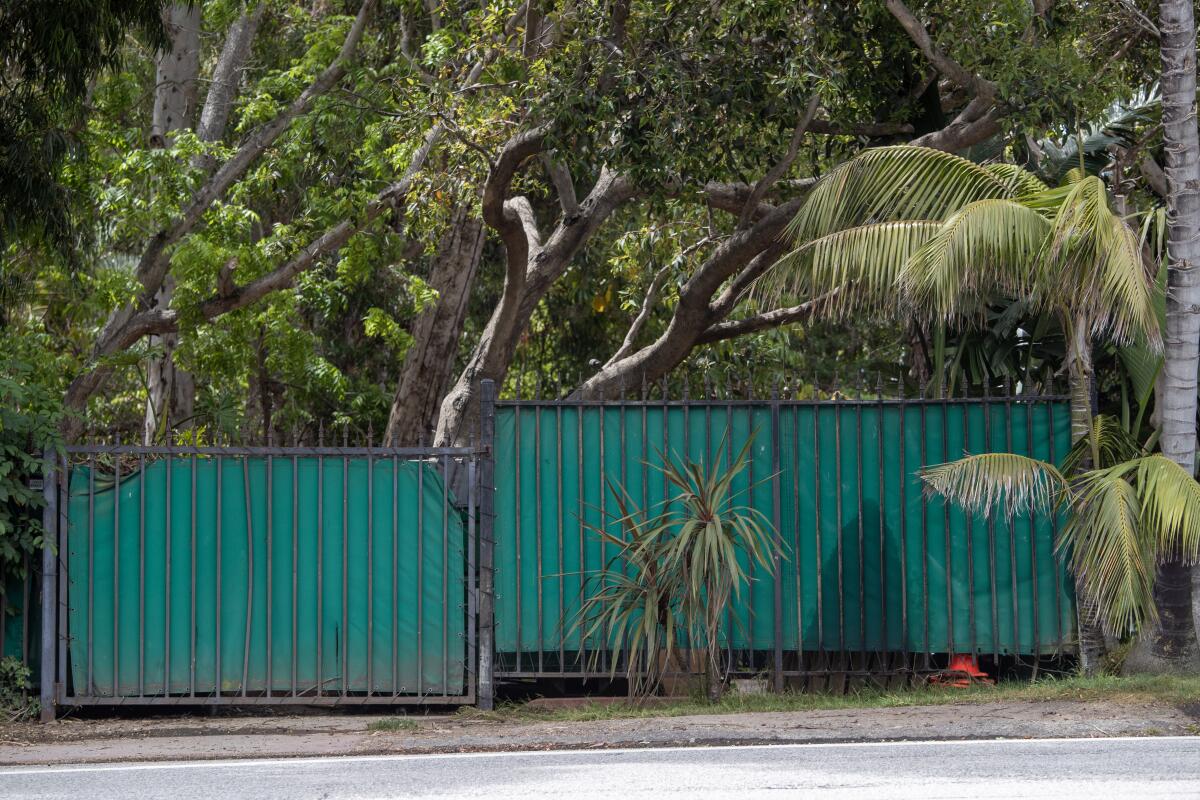
In the years and decades that followed, lot line adjustments, metal fencing, thick vegetation, paved driveways and other encroachments installed by Chiate and later Wildman further obscured the pathway and parking spaces along Pacific Coast Highway, the report said.
“Even if the public knew that the vertical public access easement was here, they could not physically use that easement,” enforcement analyst Robert Moddelmog told the commission.
Wildman purchased his property in the mid-1980s, and Mancuso in 1991.
Both argued through the 1990s and 2000s that the public accessway should be moved elsewhere, due to the difficulties of building on and improving the recorded easement area, the report said.
In California, the coastline is considered public land up to the high-tide line.
“Whenever we see access blocked to this resource that is public, and guaranteed to be public by our laws in California, we want to do our best to protect them,” said Laura Walsh, California policy manager for the nonprofit Surfrider Foundation, which supported the decision.
“We feel, really, a sense of injustice when a legal, public resource that’s ours is violated, and that’s what happened here in a very convoluted way,” she said. “We think it’s amazing that different entities were able to come together on a reasonable solution.”
A conversation with the California Coastal Commission’s newly appointed executive director on sea level rise — and the laws that safeguard our coast.
The public has not won a new highway-to-beach access point in Malibu since 2013, when the commission secured an opening from Carbon Beach property owner Lisette Ackerberg after a decades-long struggle. That access point opened in 2015.
Music mogul David Geffen similarly spent years attempting to block public access near his Carbon Beach compound before settling with the commission in 2007.
“If you say the word ‘Malibu’ to anybody in the world, they think of going to the beach, they think of surfing and beach life and picnicking and all the stuff that goes along with the California coast,” Haage said. “It’s just so ironic that there’s so few access points, and every single one, we’ve had to fight and fight and fight for.”
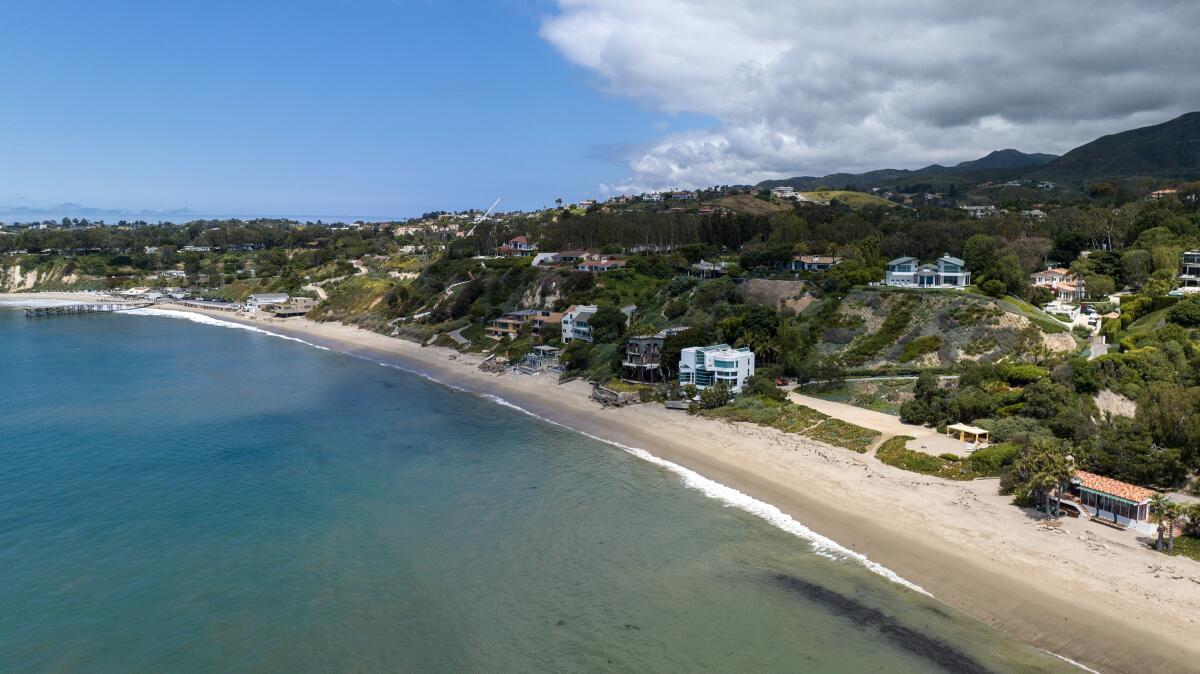
Escondido Beach, which overlooks Point Dume, is home to many wealthy residents who have long enjoyed access to the secluded spot. Nearby neighbors include billionaire David Saperstein and Jay-Z and Beyonce, whose $200 million home purchase in Paradise Cove last month shattered California price records.
Geoffrey’s is about a half-mile east of the easement. Paradise Cove Cafe is a quarter-mile west and charges up to $65 for beach parking.
The easement “really reduces the length you have to walk, particularly with gear” such as kayaks and surfboards, Walsh said. “And also, the parking that’s going to be created at the trailhead is going to be free, so it’s more equitable access in that sense.”
A new study pinpoints erosion hot spots along the entire California coast — and found that cliffs in Northern California are disappearing the fastest.
Under the agreement, the families will remove their encroachments and restore the public’s easement. They will also install five new public parking spots, a public restroom and signage along the highway.
The Wildmans will construct the accessway and parking lot, among other improvements, at an estimated cost of $3 million, the report says. Mancuso will remove an unpermitted driveway, provide land for the easement and pay a $600,000 fine.
The estimated public value of the resolution is at least $4 million, commission staff said, but the avoided cost to taxpayers is likely much higher.
Alan Block, an attorney for Mancuso, said the violations were not disclosed when he purchased the property. The circumstances have been a burden, he said.
“The Mancuso family has never done anything on the property whatsoever — they bought it the way it is — but they understand the law, and they’ve worked out an agreement and they hope the commission will approve it,” Block said ahead of Wednesday’s vote.
Wildman’s heirs similarly inherited the violations. Susan Hori, an attorney for the family, said they were pleased with the decision.
“We are very happy that the commission did support and approve the resolution,” Hori said. “And we’re very appreciative of the time that it took from staff to come and work with us on that resolution.”
Environment reporter Rosanna Xia shares her latest dispatch on sea level rise: A story of revival for both a town and a marsh that had been forgotten.
But while the victory is significant for the public, it is all the more meaningful due to changing coastal conditions driven by sea level rise, erosion and other consequences of climate change.
“We are in a really big hurry to open up as much access as possible because of sea level rise and climate change,” Haage said. “People need beaches more than ever, and we want to get people out there while there’s still a beach to go to. ... The future of access in California is uncertain, so we’re trying to do all we can now to protect it going forward.”
Commissioner Linda Escalante spoke in favor of the agreement during the meeting, and said it “helps restore the legacies of these two families, who have embraced their responsibility as stewards of this public trust land that they share with Californians.”
“In the 35 years I’ve lived in L.A. County, I’ve never set foot on this beach before, so I can’t wait until I’m able to do it while my knees still allow it,” she said.
The easement could open to the public as soon as 2024, pending necessary permits and construction, officials said.
Even on a cloudy day last week, it was easy to see the area’s appeal. The stately homes towered high above the bluff; quiet waves crashed along the shore.
Tom Pabst, a neighbor, was the only other person on the beach that day. He said he hadn’t heard about the plan, but that he was “absolutely” in favor of it.
“This is a beautiful beach,” he said. “The more public access, the better.”
More to Read
Sign up for Essential California
The most important California stories and recommendations in your inbox every morning.
You may occasionally receive promotional content from the Los Angeles Times.

